FTC Accuses Drug Makers of Collusion
May 25, 2001

- Relevant Review:
- Oligopoly
- Oligopoly Intro
- Game Theory Intro
- Sequential Games
Recently the [Outside Econweb] Federal Trade Commission (FTC) has charged some pharmaceutical firms of 'bribing' other firms to delay the introduction of generic equivalents to patented drugs. Some of the alleged bribes are on the order of US$90 million. According to the FTC, the companies in question tried to hide the bribes as license payments. In this article we won't concern ourselves with whether or not these charges are true in any of the instances involved, rather we will show how this behavior can be modeled as a sequential game.
Pharmaceutical companies usually apply for a patent on a potential drug as soon as they find a substance that they believe to be promising. The drug is tested and if it receives [Outside Econweb] Federal Drug Administration (FDA) approval, during the period while the drug enjoys a patent, its manufacture and sale can be extremely profitable. However, estimates are that, during the first year after a patent expires, approximately 80% of market share for a drug is lost to generic competitors. Profits for the no-longer-patented drug can drop by several hundred million in a single year when a generic equivalent is introduced.
|
The situation we examine here is a sequential game, which we illustrate with a game tree. To the right we show the strategies available to Pharmaceutical Company A (Pharm A), the company that sells a widely used drug for which the patent is about to expire. Pharm A knows that it will soon face generic competitors. Its choices are to allow this to happen (Don't Bribe) or to try to bribe competitors to withhold production of a generic equivalent (Bribe). We show these strategies (choices) as two branches on a game tree.
|
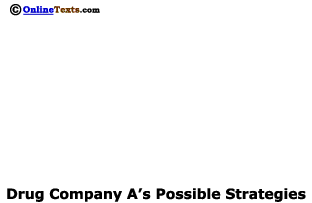 |
|
|
Pharmaceutical Company B (Pharm B) also has two possible strategies (choices). It can produce a generic equivalent of the drug made by Pharm A when the patent expires (labeled Generic on the top branch to the right), or it can produce no competing product (labeled No Generic on the bottom branch).
|
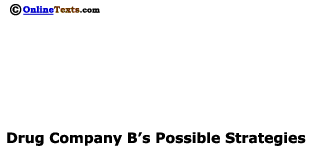 |
|
It is reasonable to assume that pharmaceutical companies are profit maximizers, so the choices made will depend on the payoffs expected to result from the various strategies. We know what choices the companies are accused of making, so our task is to see if these choices can be reasonably explained as a sequential game.
|
Each pharmaceutical company has two possible strategies (choices) in this game; however, because Pharm A acts first, we show Pharm B's choices twice, once for each possible strategy pursued by Pharm A. This means there are a total of four possible outcomes, which will be shown at the end of the four branches on the right.
Top Branch: Pharm A Bribes and Pharm B produces a Generic equivalent
Second Branch: Pharm A Bribes and Pharm B does not produce a Generic equivalent
Third Branch: Pharm A Does Not Bribe and Pharm B produces a Generic equivalent
Bottom Branch: Pharm A Does Not Bribe and Pharm B does not produce a Generic equivalent
|
 |
|
|
To the right we show the complete game tree with payoffs for both firms. We don't know the actual payoffs (profits) in each instance, but we can make some reasonable guesses on the profit differences based on the size of the bribes the FTC claims were paid. One company (in a situation like that of Pharm A) has been charged with paying bribes of 90 million to another company (like Pharm B) for delaying introduction of a generic equivalent for one year. It's reasonable to assume that Pharm A's profits will fall by at least 90 million if a generic equivalent is introduced, and that Pharm B's profits would rise by no more than 90 million if it were to introduce a generic equivalent. Thus, a bribe of 90 million paid and accepted would increase profits for both companies over the no-bribe scenario. For this to all make sense, Pharm B has to believe that the consequences of "cheating" on the agreement are dire, otherwise it might "cheat" by accepting the bribe and still produce a generic equivalent. One consequence of "cheating" is that no bribe would ever be offered again. Another possible consequence is that, if Pharm B cheats and introduces a generic after accepting a bribe, Pharm A will heavily market and steeply discount the "name-brand" drug, causing Pharm B to lose money on the generic. For these reasons, the payoff to Pharm B for accepting the bribe and producing a generic is not very high.
The numbers to the far right on the game tree are the payoffs to each of the firms in each of the possible four outcomes from this simple game. The first number in each pair (in blue) is the payoff to Pharm A and the second is the payoff to Pharm B. For example, if Pharm A chooses Don't Bribe (the lower half of the game tree) and Pharm B chooses to market a Generic (third branch), Pharm A earns profits of 10 million and Pharm B earns profits of 60 million.
|
 |
|
|
As we learned in the section on sequential games, these games are solved by starting at the end of the game and working backwards. First, let's consider the case in which Pharm A chooses the Don't Bribe strategy. We've made this easier to see by "graying out" the upper half of the game tree. If Pharm A does not offer a bribe, Pharm B finds itself facing a choice of producing a generic equivalent and earning profits of 60 million, or failing to produce a generic equivalent and earning profits of only 20 million. It is clear that Pharm B will produce and market a Generic if Pharm A does not bribe them, so Pharm A's knows that its profits from choosing the Don't Bribe strategy will be 10 million.
|
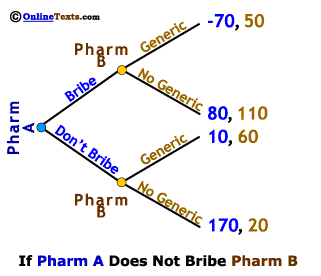
|
|
|
Next, we examine the case in which Pharm A Bribes Pharm B, again by first examining how Pharm B would behave in this setting. We've grayed out the bottom half of the game tree so as to focus only on the top portion. Pharm B has two choices if it accepts a Bribe: 1) Produce a Generic giving it profits of 50 million or 2) Produce No Generic equivalent of the drug in question, so that with the Bribe in hand its profits come to 110 million. Pharm B is a profit maximizing firm so it will clearly produce No Generic if Pharm A pays the Bribe. Pharm A knows that its profits from choosing the Bribe strategy will be 80 million.
|
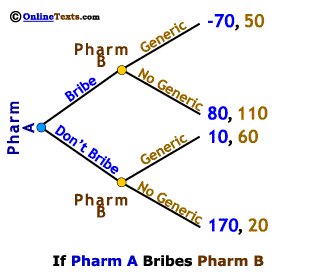 |
|
|
If Pharm A pays the bribe to Pharm B, its profits are 80 million, while if it does not pay the bribe its profits are only 10 million. Whether the FTC is right or not, it is clear that there are sufficient financial incentives for such actions to be considered. In one recent case, the FTC claims a company paid an US$89 million bribe and earned an additional US$700 million in the next eleven months as a result of the delayed introduction of a generic equivalent of a drug used for high blood pressure and heart disease. They estimate that the average user of the drug paid an additional US$400 per year as a result of the delay of the introduction of a generic equivalent.
|
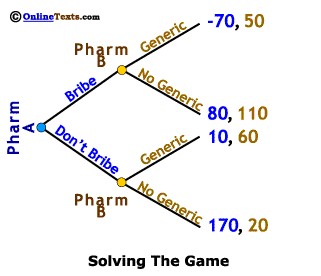 |
|
Copyright © 1995-2003 OnLineTexts.com, Inc. - All Rights Reserved







